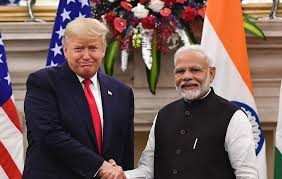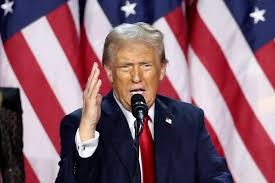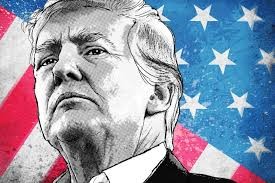
Pics courtesy Internet
My Article Published on The EurasianTimes Website on 07 Nov 24.
Donald Trump’s return will have many implications for India regarding economics, security, and global alignments. Trump is more of a businessman and generally favours bilateral trade deals over multilateral ones. He may advocate a more transactional approach in his second tenure, focusing on trade deficits. His previous administration’s tariff policies targeted many trading partners, including India, which saw increased duties on certain exports. India might face pressure to expand its markets to American goods, particularly in the agriculture, pharmaceuticals, and technology sectors. Trump’s previous immigration policies impacted the H-1B visa program, which disproportionately affected Indian workers in the tech sector. A return to these policies could limit Indian talent mobility, impacting both individuals and companies. India’s IT sector might find the U.S. less accessible for skilled migration, though Trump has sometimes indicated support for highly skilled immigration.

Security Repercussions for India
Trump’s “America First” approach sometimes means stepping back from global commitments, including military engagements abroad. If the U.S. were to reduce its military presence in Asia, this could shift greater responsibility to regional players. While India is enhancing its military capabilities, a significant U.S. pullback from the region could embolden China or other adversarial forces, increasing security pressure on India. India’s security landscape will be affected in several ways, especially concerning regional stability, defence partnerships, and counterterrorism.
Increased Demand for Strategic Alignment with the U.S. A Trump victory could mean heightened expectations for India to align with U.S. policies in the region, which could be at odds with India’s traditionally non-aligned stance. India might face pressure to take more decisive stances on issues like Taiwan, South China Sea disputes, and participation in regional blocs led by the U.S. India may have to weigh its economic and diplomatic ties with other countries, particularly Russia, against the U.S. demands for closer alignment.
China-India-U.S. Dynamics. Trump’s “Indo-Pacific” strategy strongly focuses on containing China, and a second term would likely deepen this agenda, intensifying U.S.-China competition. India would likely be asked to take a more assertive role in regional security, particularly in the Indian Ocean. While India could benefit from U.S. support in balancing China’s influence, it also risks being pulled into a more intense, potentially destabilising rivalry, which might strain its resources and complicate diplomatic relations with China.
Impact on the Quad Alliance. Trump has supported the Quad (U.S., India, Japan, and Australia), seeing it as a counterweight to China’s influence. His re-election could lead to an expanded Quad agenda, including more security collaboration in the Indian Ocean and South China Sea. This might benefit India’s strategic standing but could also draw it into more confrontation with China. The Quad’s increased visibility may create additional security risks, with China potentially reacting aggressively in the region, impacting India’s borders and maritime security.
Pakistan Policy. Trump previously adopted a tough stance on Pakistan, particularly regarding terrorism financing and harbouring militant groups that target Afghanistan and India. He may again apply pressure on Pakistan to dismantle terrorist networks. This would align with India’s security goals, potentially reducing cross-border terrorism. However, any diplomatic tension between the U.S. and Pakistan could destabilise, making Pakistan lean more heavily toward China and impacting India’s security environment.
Afghanistan’s Security Dynamics. Trump had strongly advocated withdrawing U.S. forces from Afghanistan. While a complete withdrawal has already taken place, his potential re-election could mean a lack of further U.S. engagement in Afghan stability, especially in containing Taliban and extremist groups. For India, this would mean facing an increasingly Taliban-influenced Afghanistan, leading to higher security risks, especially if terror groups resurge in the region.

Repercussions on Military Cooperation
Trump’s administration fostered strong defence cooperation with India as part of a broader Indo-Pacific strategy to counterbalance China’s growing influence. However, Trump’s unpredictable alliance approach could lead India to exercise caution. The repercussions on military cooperation between the U.S. and India could be multifaceted, introducing new strategic dynamics.
Strengthened Defence Partnership. Trump’s administration previously prioritised India as a significant defence partner within the Indo-Pacific framework. A second term could intensify military cooperation. India may receive advanced technology and intelligence sharing, and joint exercises could increase frequency and complexity. However, this could also increase India’s security obligations in the Indo-Pacific, putting it on the front lines of any U.S.-China friction in the region.
Enhanced Defence Technology and Arms Transfers. Under Trump, the U.S. could prioritise India as a key buyer of advanced defence equipment, including drones, anti-missile systems, and surveillance technology. India has acquired U.S. assets like C-17 heavy lift aircraft, C-130 Special operation aircraft, Apache attack helicopter, Chinook heavy lift helicopter, and P-8I Poseidon surveillance aircraft. A second Trump term might accelerate such sales, particularly if the U.S. encourages India to purchase high-tech systems that enhance its capabilities against China.
Military Modernisation. Trump’s administration previously pushed for arms deals with India, and a second term could further expand India’s access to U.S. military technology. This could accelerate India’s modernisation efforts, potentially providing advanced systems and technologies. Trump’s administration might push for more defence manufacturing in India through programs like “Make in India.” The U.S. could support joint ventures and technology transfers to Indian companies, allowing India to produce components of high-tech defence systems locally. While this would strengthen India’s defence manufacturing sector, there might be strings attached, with the U.S. expecting greater access to India’s defence markets and influence over India’s arms export policies.
Counterterrorism and Intelligence Sharing. Trump’s stance on counterterrorism aligns with India’s interests, and military cooperation could extend to enhanced intelligence-sharing agreements. The U.S. has been a critical partner in sharing counterterrorism intelligence with India, which helps prevent potential terrorist attacks. India’s counterterrorism efforts could be bolstered if Trump maintains or deepens intelligence sharing. However, if his administration decides to limit or privatise specific intelligence-sharing mechanisms, India might face challenges acquiring timely information.
Cyber security and Space Warfare Collaboration. Trump has shown interest in cyber defence and space as critical domains of warfare. Cooperation in these fields could deepen under his presidency, with the U.S. assisting India in building its space-based surveillance and cyber security capacities. This could help India counter cyber threats from adversaries like China and strengthen satellite surveillance of sensitive border areas. However, tighter coordination in these domains might push India further into the U.S. strategic orbit, affecting its autonomy in setting space and cyber policies.
Joint Military Exercises and Training. Military exercises like the Malabar naval drills have seen increased engagement from all Quad members (U.S., India, Japan, and Australia), aiming to boost interoperability among the forces. With Trump in office, India may face opportunities for more profound joint training and exercises, extending into new domains like cyber and space warfare.
Conclusion. Trump’s second tenure could bring some alignment on shared geopolitical interests but might introduce new uncertainties, especially in trade and immigration policies. It could deepen the relationship between the U.S. and India regarding strengthened defence cooperation and intelligence, enabling India to access advanced defence technologies and participate more actively in joint exercises. However, India might face growing expectations to align with U.S. policies in Asia, potentially narrowing its strategic autonomy and requiring it to manage and navigate a delicate and complex regional security landscape. India must weigh these factors carefully, balancing cooperation with the U.S. against its regional interests.
Your valuable comments are most welcome.
For regular updates, please register your email here:-
References and credits
To all the online sites and channels.
Disclaimer:
Information and data included in the blog are for educational & non-commercial purposes only and have been carefully adapted, excerpted, or edited from reliable and accurate sources. All copyrighted material belongs to respective owners and is provided only for wider dissemination.
